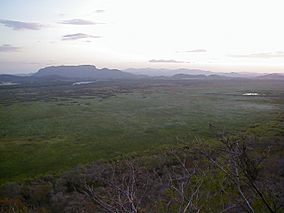Palo Verde National Park facts for kids
Quick facts for kids Palo Verde National Park |
|
|---|---|
|
IUCN Category II (National Park)
|
|

Marshlands flanking the Tempisque River in Palo Verde National Park
|
|
| Location | Costa Rica |
| Area | 184 km2 |
| Established | 1978 |
| Governing body | National System of Conservation Areas (SINAC) |
| Official name: Palo Verde | |
| Designated: | 27 December 1991 |
| Reference #: | 540 |
Palo Verde National Park (Spanish: Parque Nacional Palo Verde) is a special place in Costa Rica. It is a national park that helps protect a very important natural area. This park is found in the Guanacaste Province, about 30 kilometers west of Canas. It covers a large area of 45,492 acres.
The park is mostly made up of tropical dry forests. It also protects important floodplains, marshes, and seasonal pools. These areas are vital for many animals and plants. The park helps keep these natural habitats safe from human activities.
Contents
Exploring Palo Verde National Park
Palo Verde National Park has a ranger station for visitors. It is open from 8 AM until sunset. You can find clean water and restrooms there. The Organization for Tropical Studies also runs the Palo Verde Biological Station inside the park. This station helps scientists study the area.
Amazing Birdlife
One of the most exciting things about Palo Verde is its incredible variety of birds. The park was created mainly to protect these birds. It has 15 different types of natural areas, from evergreen forests to mangrove swamps. This means many different birds can live there.
You can often spot amazing birds like great curassows and bright scarlet macaws. Other common birds include white ibis, roseate spoonbills, and anhingas. You might even see large jabirus and wood storks.
During Costa Rica's dry season, water can be hard to find in other places. Because of this, many birds fly to Palo Verde National Park. They gather around the Tempisque River basin. Parajos Island, located in the middle of the Tempisque River, is a fantastic spot to see birds. It is the biggest nesting place in Costa Rica for black-crowned night-herons.
Protecting Endangered Ecosystems
Palo Verde National Park protects one of the most endangered natural areas on Earth. It is one of the last remaining tropical dry rainforests. These forests once covered most of Central America. Today, less than 0.1% of their original size is left. This makes them the most endangered ecosystems in tropical regions.
History of the Park
Palo Verde National Park was first set aside as a wildlife refuge in the 1970s. This was because over 60 different kinds of birds used its wetlands as a stop during their long migrations. During the dry season, there were once thousands of black-bellied whistling ducks and blue-winged teal.
Later, the area was officially made a national park. It is managed by a government agency called MINAE. In the 1990s, the park was added to the Ramsar list of wetlands of international importance. This list recognizes wetlands that are very important for nature around the world. It was also placed on the Montreux Record, which highlights wetlands that need special attention.
See also
 In Spanish: Parque nacional Palo Verde para niños
In Spanish: Parque nacional Palo Verde para niños

